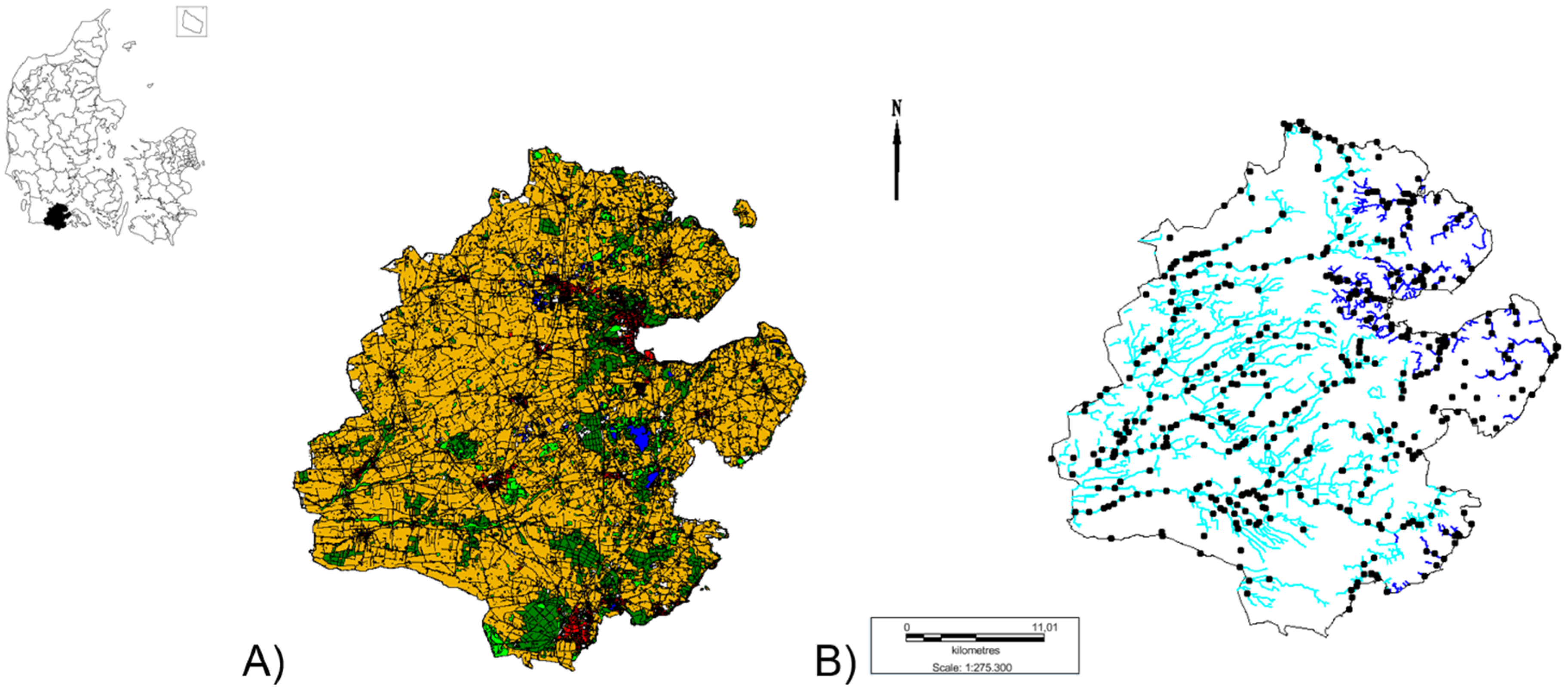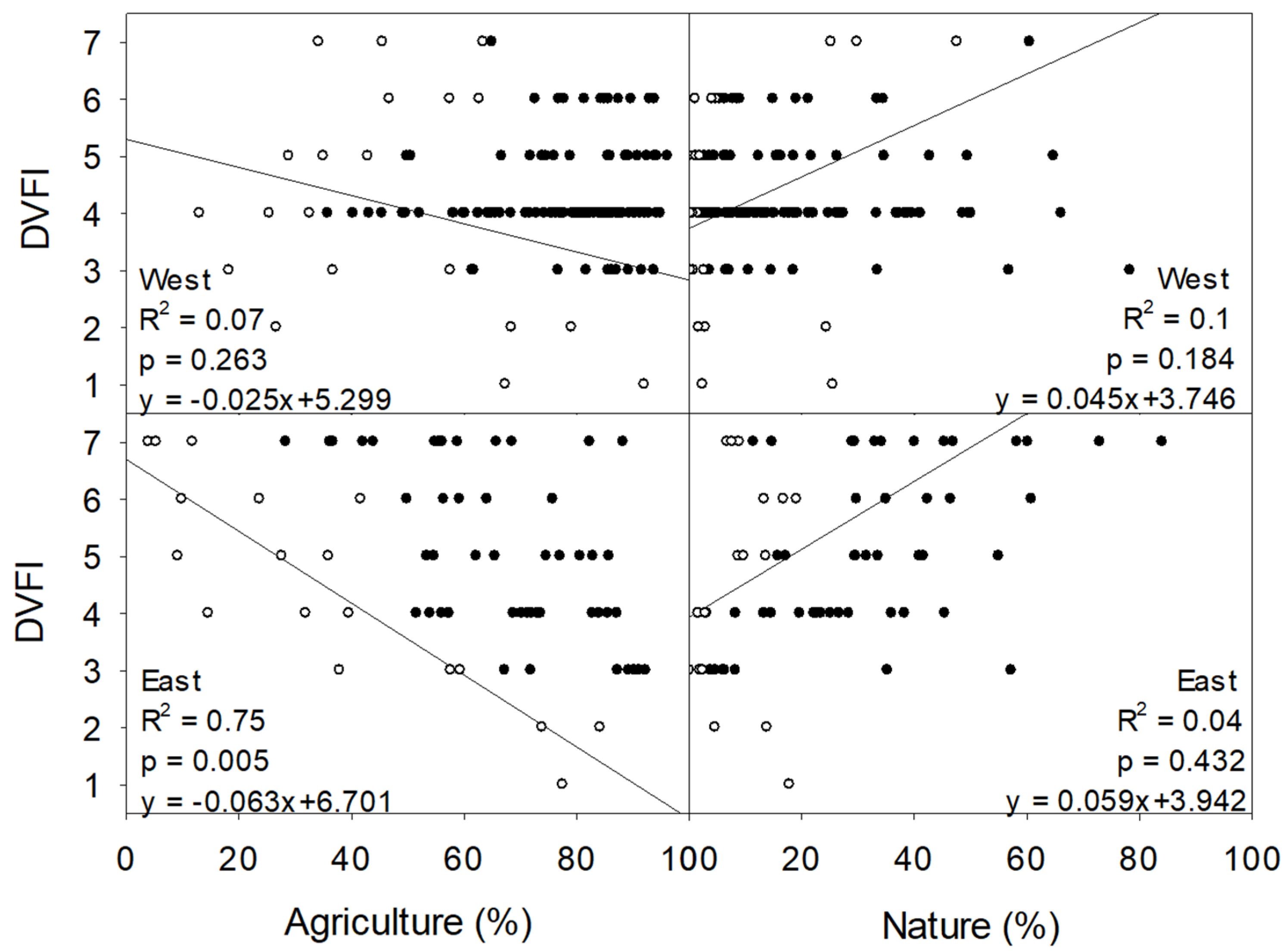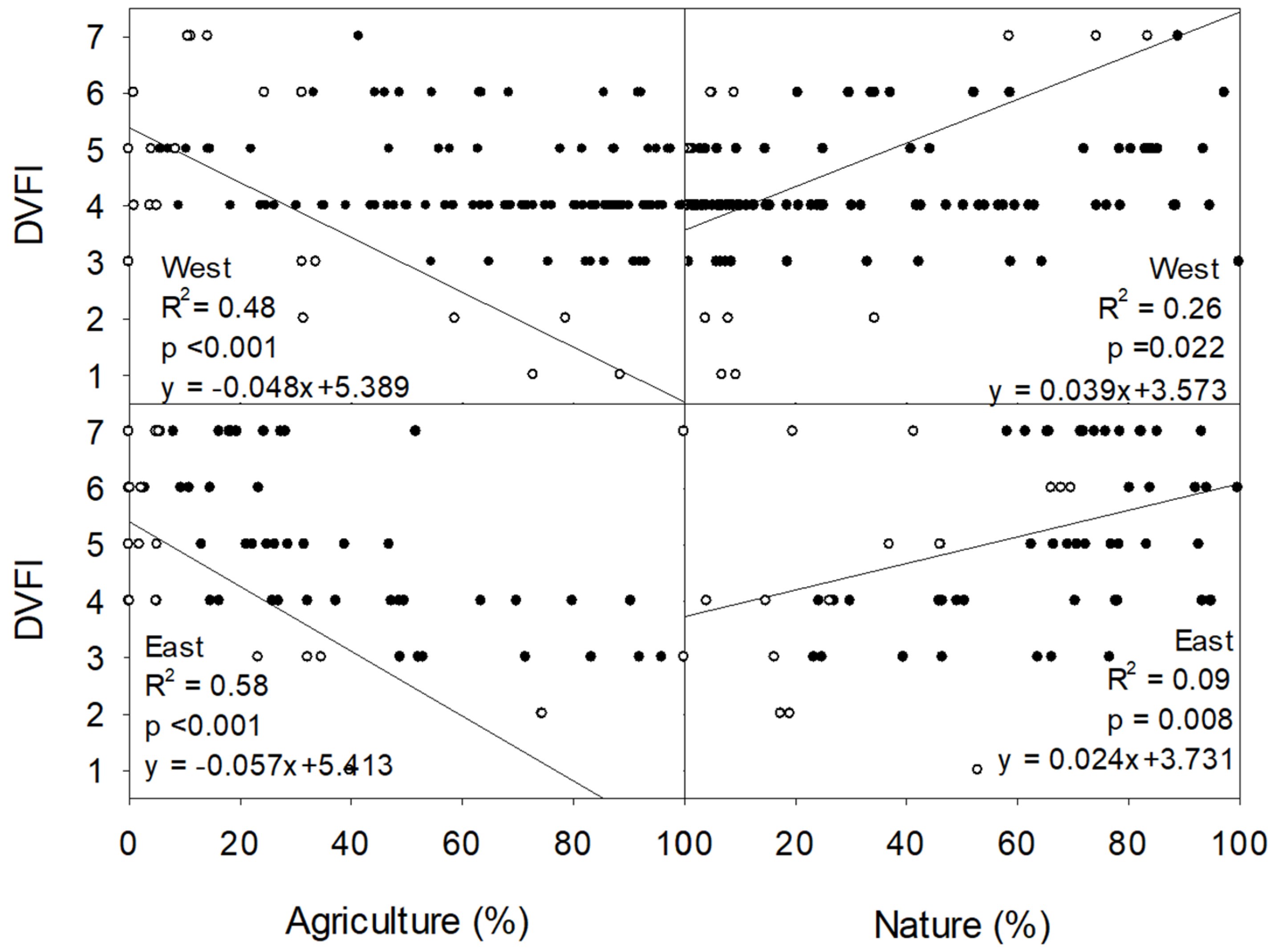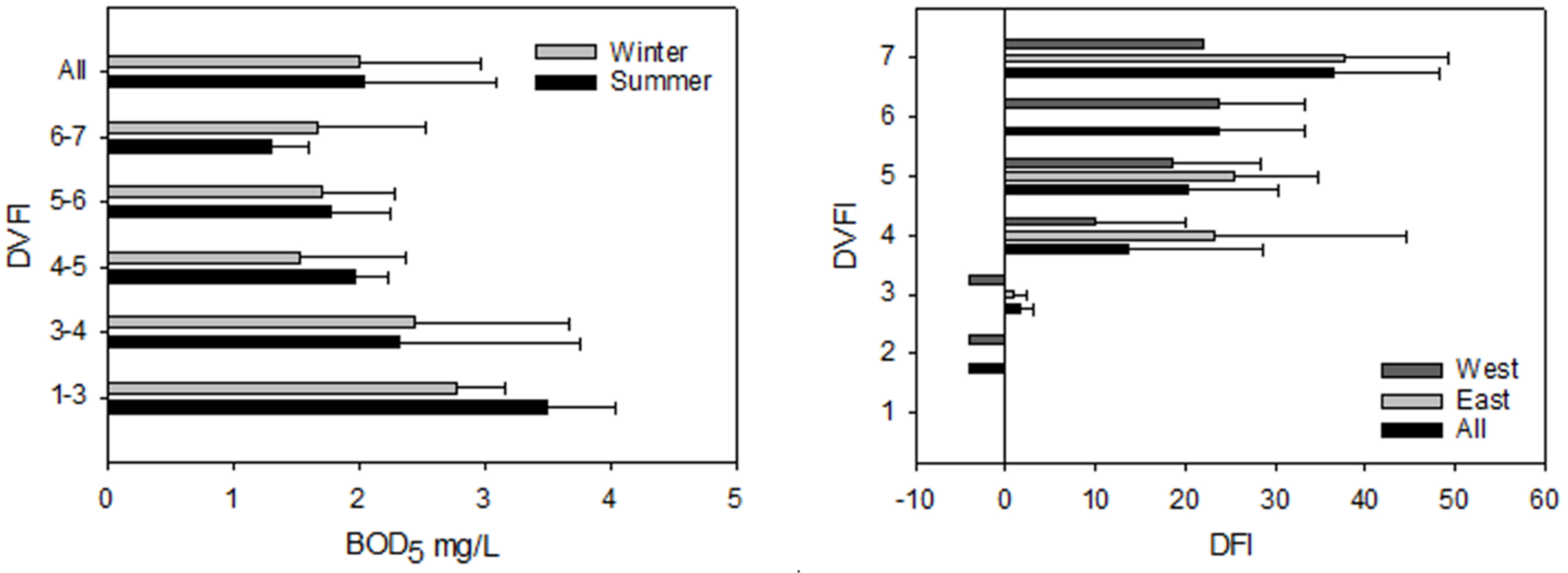Impact of Land Use and Runoff on Stream Quality
Abstract
1. Introduction
2. Materials and Methods
3. Results
3.1. Land Use and Stream Characteristics
3.2. Stream Quality vs. Land Use
3.3. BOD5, Metals, and DFI
3.4. Influence from Nature/Forest and Urban Areas
4. Discussion
5. Conclusions
Author Contributions
Funding
Acknowledgments
Conflicts of Interest
References
- Chubb, C.; Griffiths, M.; Spooner, S. Regulation for water quality—How to safeguard the water environment. In Partnership with the European Union; Foundation for Water Research: Cambridge, UK, 2014; pp. 12–187. [Google Scholar]
- Ledin, A.; Auffarth, K.P.S.; Boe-Hansen, R.; Eriksson, E.; Albrechtsen, H.J.; Baun, A.; Mikkelsen, Å.S. Use of stormwater collected from roofs and paved areas—Identification of relevant parameters for measurements. Ecol. Urban. Renew. Wastewater Treat. 2004, 48, 11–29. (In Danish) [Google Scholar]
- Coleman, J.C.; Miller, M.C.; Mink, F.L. Hydrologic disturbance reduces biological integrity in urban streams. Environ. Monit. Assess. 2011, 172, 663–687. [Google Scholar] [CrossRef] [PubMed]
- Wang, B.X.; Liu, D.X.; Liu, S.R.; Zhang, Y.; Lu, D.Q.; Wang, L.Z. Impacts of urbanization on stream habitats and macroinvertebrate communities in the tributaries of Qiangtang River, China. Hydrobiologia 2012, 680, 39–51. [Google Scholar] [CrossRef]
- Mallin, M.A.; Johnson, V.L.; Ensign, S.H. Comparative impacts of stormwater runoff on water quality of an urban, a suburban, and a rural stream. Environ. Monit. Assess. 2009, 159, 475–491. [Google Scholar] [CrossRef]
- Seifert, A.G.; Roth, V.N.; Dittmar, T.; Gleixner, G.; Breuer, L.; Houska, T.; Marxsen, J. Comparing molecular composition of dissolved organic matter in soil and stream water: Influence of land use and chemical characteristics. Sci. Total Environ. 2016, 571, 142–152. [Google Scholar] [CrossRef] [PubMed]
- Pedersen, E.R.; Perkins, M.A. The use of benthic invertebrate data for evaluating impacts of urban runoff. Hydrobiologia 1986, 139, 13–22. [Google Scholar] [CrossRef]
- Davies, P.J.; Wright, I.A.; Findlay, S.J.; Jonasson, O.J.; Burgin, S. Impact of urban development on aquatic macroinvertebrates in south eastern Australia: Degradation of in-stream habitats and comparison with non-urban streams. Aquat. Ecol. 2010, 44, 685–700. [Google Scholar] [CrossRef]
- Walsh, C.J.; Roy, A.H.; Feminella, J.W.; Cottingham, P.D.; Groffman, P.M.; Morgan, R.P. The urban stream syndrome: Current knowledge and the search for a cure. J. North Am. Benthol. Soc. 2005, 24, 706–723. [Google Scholar] [CrossRef]
- Kronvang, B.; Laubel, A.R.; Larsen, S.E.; Iversen, H.L. Soil erosion and sediment delivery through buffer zones in Danish slope units. The Role of Erosion and Sediment Transport in Nutrient and Contaminant Transfer. In Proceedings of the Symposium, Waterloo, ON, Canada, July 2000; pp. 67–73. Available online: http://hydrologie.org/redbooks/a263/iahs_263_0067.pdf (accessed on 3 October 2019).
- Vietz, G.J.; Walsh, C.J.; Fletcher, T.D. Urban hydrogeomorphology and the urban stream syndrome: Treating the symptoms and causes of geomorphic change. Prog. Phys. Geog. 2016, 40, 480–492. [Google Scholar] [CrossRef]
- Blankenberg, A.B.; Haarstad, K.; Paruch, A.M. Agricultural Runoff in Norway: The problem, the regulations, and the role of wetlands. In The Role of Natural and Constructed Wetlands in Nutrient Cycling and Retention on the Landscape; Vyamazal, J., Ed.; Springer International Publishing: Basel, Switzerland, 2014; pp. 137–147. [Google Scholar]
- Mateo-Sagasta, J.; Zadeh, S.M.; Turral, H. Water Pollution from Agriculture: A Global Review—Executive Summary; The Food and Agriculture Organization of the United Nations Rome and the International Water Management Institute on Behalf of the Water Land and Ecosystems research program Colombo: Rome, Italy; The International Water Management Institute on Behalf of the Eater Land and Ecosystems Research program Colombo: Colombo, Sri Lanka, 2017. [Google Scholar]
- Schoumans, O.F.; Chardon, W.J.; Bechmann, M.; Cascuel-Odoux, C.; Hofman, G.; Kronvang, B.; Litaor, M.I.; Lo Porto, A.; Newell-Price, P.; Rubæk, G. Mitigation Options for Reducing Nutrient Emissions from Agriculture; A Study Amongst European Member States of Cost Action 869; Alterra-Report 2141; Alterra Wageningen UR: Wageningen, The Netherlands, 2011; pp. 11–143. [Google Scholar]
- The Ministry of Environment, Danish Nature Agency. Water Environment and Nature 2016; The Ministry of Environment: Copenhagen, Denmark, 2018; pp. 13–23.
- The Ministry of Environment, Danish Nature Agency. Point Sources 2013; The Ministry of Environment: Copenhagen, Denmark, 2015; pp. 9–36.
- Steedman, R.J. Modification and Assessment of an index of biotic integrity to quantify stream quality in Southern Ontario. Can. J. Fish. Aquat. Sci. 2011, 45, 492–501. [Google Scholar] [CrossRef]
- Hooper, R.P.; Aulenbach, B.T.; Kelly, V.J. The national stream quality accounting network: A flux-based approach to monitoring the water quality of large rivers. Hydrol. Process. 2018, 15, 1089–1106. [Google Scholar] [CrossRef]
- Li, S.; Gu, S.; Tan, X.; Zhang, Q. Water quality in the upper Han River basin, China: The impacts of land use/land cover in riparian buffer zone. J. Hazard. Mater. 2009, 165, 317–324. [Google Scholar] [CrossRef] [PubMed]
- Kelly, M.G.; Cazaubon, E.; Coring, A.; Dell’Uomo, L.; Ector, B.; Goldsmith, H.; Guasch, J.; Hürlimann, A.; Jarlman, B.; Kawecka, J.; et al. Recommendations for the routine sampling of diatoms for water quality assessments in Europe. J. Appl. Phycol. 1998, 10, 215. [Google Scholar] [CrossRef]
- Rotvit, L.; Jacobsen, D. Temperature increase and respiratory performance of macroinvertebrates with different tolerances to organic pollution. Limnologica 2013, 43, 510–515. [Google Scholar] [CrossRef]
- Friberg, N.; Baattrup-Pedersen, A.; Pedersen, M.L.; Skriver, J. The new Danish stream monitoring programme (NOVANA)—Preparing monitoring activities for the water framework directive era. Environ. Monit. Assess. 2005, 111, 27–42. [Google Scholar] [CrossRef]
- Kronvang, B.; Grant, R.; Larsen, S.E.; Svendsen, L.M.; Kristensen, P. Non-point-source nutrient losses to the aquatic environment in Denmark: Impact of agriculture. Mar. Freshw. Res. 1995, 46, 167–177. [Google Scholar] [CrossRef]
- Paul, M.J.; Meyer, J.L. Streams in the urban landscape. Annu. Rev. Ecol. Syst. 2001, 32, 333–365. [Google Scholar] [CrossRef]
- Egemose, S.; Sønderup, M.J.; Grudinina, A.; Hansen, A.S.; Flindt, M.R. Heavy metal composition in stormwater and retention in ponds dependent on pond age, design and catchment type. Environ. Technol. 2014, 36, 959–969. [Google Scholar] [CrossRef]
- Sønderup, M.J.; Egemose, S.; Hansen, A.S.; Grudinina, A.; Madsen, M.H.; Flindt, M.R. Factors affecting retention of nutrients and organic matter in stormwater ponds. Ecohydrology 2016, 9, 796–806. [Google Scholar] [CrossRef]
- Statistics Denmark. Available online: http://www.dst.dk/da/Statistik/nyt/NytHtml?cid=28143 (accessed on 22 August 2019).
- Kucuksezgin, F.; Uluturhan, E.; Batki, H. Distribution of heavy metals in water, particulate matter and sediments of Gediz River (Eastern Aegean). Environ. Monit. Assess. 2008, 141, 213–225. [Google Scholar] [CrossRef]
- Sørensen, S.; Petersen, B.; Kofod, N.; Jacobsen, P. Historical overview of the Copenhagen sewerage system. Water Pract. Technol. 2006, 1, 1–8. [Google Scholar] [CrossRef]
- Brombach, H.; Weiss, G.; Fuchs, S. A new database on urban runoff pollution: Comparison of separate and combined sewer systems. Water Sci. Technol. 2005, 51, 119–128. [Google Scholar] [CrossRef] [PubMed]
- Virbickas, T.; Pliuraité, V.; Kesminatas, V. Impact of Agricultural Land Use on Macroinvertebrate Fauna in Lithuania. Pol. J. Environ. Stud. 2011, 20, 1327–1334. [Google Scholar]
- Chase, J.W.; Benoy, G.A.; Hann, S.W.R.; Culp, J.M. Small differences in riparian vegetation significantly reduce land use impacts on stream flow and water quality in small agricultural watersheds. J. Soil Water Conserv. 2016, 71, 194–205. [Google Scholar] [CrossRef]
- Odum, E.P.; Finn, J.T.; Franz, E.H. Perturbation theory and the subsidy-stress gradient. BioScience 1979, 29, 349–351. [Google Scholar] [CrossRef]
- Quinn, J.M. Effects of pastoral development. In New Zealand Stream Invertebrates: Ecology and Implications for Management; Collier, K.J., Winterbourn, M.J., Eds.; Caxton Press: Christchurch, New Zealand, 2000; pp. 208–229. [Google Scholar]
- Richards, S.; Withers, P.; Paterson, E.; Stutter, M.I. Temporal variability in domestic point source discharges and their associated impact on receiving waters. Sci. Total Environ. 2016, 571, 1275–1283. [Google Scholar] [CrossRef]
- Hart, S.K.; Hibbs, D.E.; Perakis, S.S. Riparian litter inputs to streams in the central Oregon Coast Range. Freshw. Sci. 2013, 32, 343–358. [Google Scholar] [CrossRef]





| DVFI | Catchment | Agriculture (%) | Nature (%) | Urban (%) |
|---|---|---|---|---|
| 7 | Total/50 m buffer/10 m buffer | 47/35/27 | 37/52/60 | 15/13/13 |
| 6 | Total/50 m buffer/10 m buffer | 67/41/32 | 20/52/60 | 13/8/8 |
| 5 | Total/50 m buffer/10 m buffer | 69/46/38 | 20/44/52 | 11/10/10 |
| 4 | Total/50 m buffer/10 m buffer | 70/64/58 | 18/28/31 | 13/9/11 |
| 3 | Total/50 m buffer/10 m buffer | 73/69/65 | 16/25/29 | 11/5/6 |
| 2 | Total/50 m buffer/10 m buffer | 66/70/64 | 10/16/17 | 24/14/20 |
| 1 | Total/50 m buffer/10 m buffer | 79/66/67 | 15/28/23 | 6/6/10 |
| DVFI | Nature/Forest (%) | Combined Sewer (%) | Separate Sewer (%) | Scattered Houses (houses/km2) |
|---|---|---|---|---|
| 7 | 90 ± 13 | 0 ± 1 | 10 ± 13 | 2.4 ± 0.4 |
| 6 | 81 ± 20 | 1 ± 4 | 18 ± 20 | 3.7 ± 0.4 |
| 5 | 77 ± 26 | 4 ± 10 | 19 ± 23 | 3.9 ± 0.6 |
| 4 | 74 ± 30 | 5 ± 12 | 21 ± 26 | 5.4 ± 1 |
| 3 | 56 ± 34 | 16 ± 20 | 28 ± 25 | 4.9 ± 0.4 |
| 2 | 35 ± 26 | 28 ± 23 | 37 ± 24 | 2.3 ± 0.1 |
| 1 | 55 ± 32 | 16 ± 21 | 29 ± 29 | 5.4 ± 3.5 |
© 2019 by the authors. Licensee MDPI, Basel, Switzerland. This article is an open access article distributed under the terms and conditions of the Creative Commons Attribution (CC BY) license (http://creativecommons.org/licenses/by/4.0/).
Share and Cite
Karlsen, C.S.; Flindt, M.R.; Sønderup, M.J.; Madsen, M.H.; Egemose, S. Impact of Land Use and Runoff on Stream Quality. Sustainability 2019, 11, 5479. https://doi.org/10.3390/su11195479
Karlsen CS, Flindt MR, Sønderup MJ, Madsen MH, Egemose S. Impact of Land Use and Runoff on Stream Quality. Sustainability. 2019; 11(19):5479. https://doi.org/10.3390/su11195479
Chicago/Turabian StyleKarlsen, Claudia S., Mogens R. Flindt, Melanie J. Sønderup, Martin H. Madsen, and Sara Egemose. 2019. "Impact of Land Use and Runoff on Stream Quality" Sustainability 11, no. 19: 5479. https://doi.org/10.3390/su11195479
APA StyleKarlsen, C. S., Flindt, M. R., Sønderup, M. J., Madsen, M. H., & Egemose, S. (2019). Impact of Land Use and Runoff on Stream Quality. Sustainability, 11(19), 5479. https://doi.org/10.3390/su11195479





